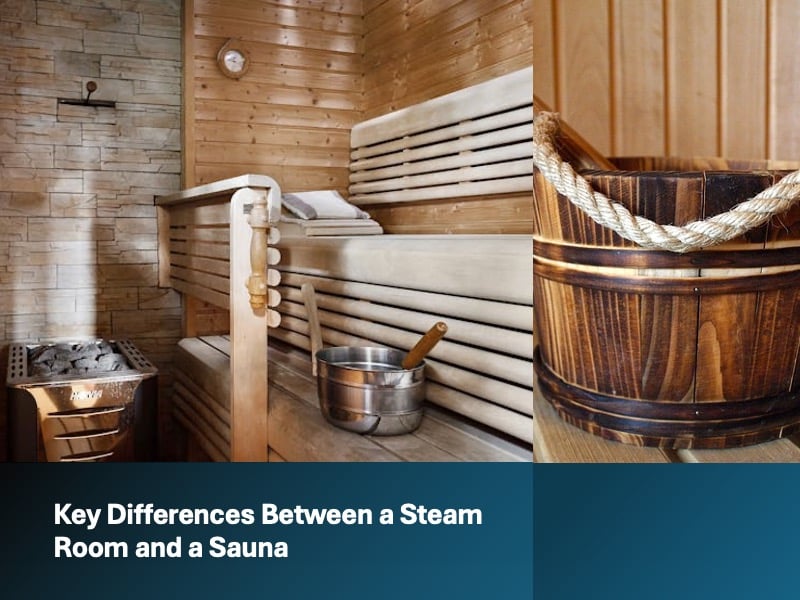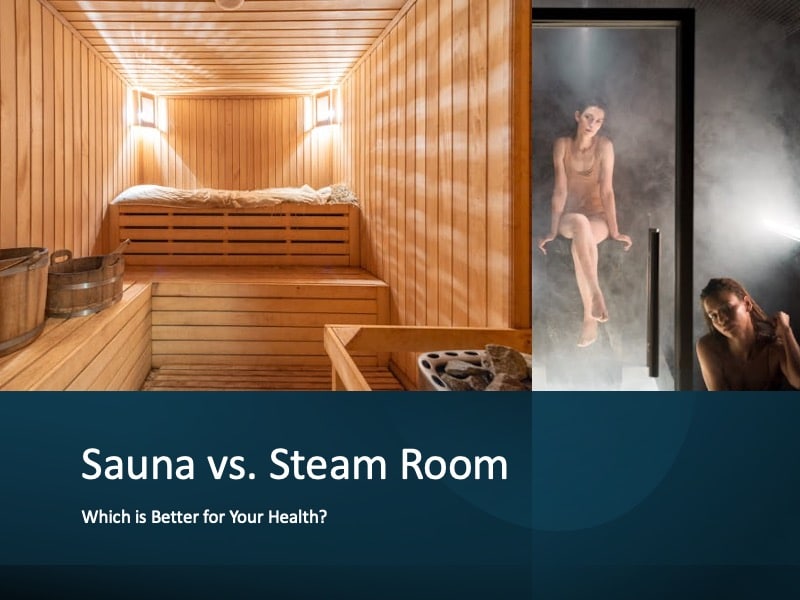Sauna vs. Steam Room – Which is Better for Your Health?
Saunas and steam rooms have been used for centuries as powerful tools for relaxation and recovery, but their effects on the body are remarkably different.
The intense, dry heat of a sauna and the deep, humid warmth of a steam room each provide unique physiological benefits, making one better suited for certain health goals than the other.
While both saunas and steam rooms offer valuable health benefits, they each excel in different areas, making one more effective than the other depending on your specific wellness goals.
Whether you’re looking to improve cardiovascular health, enhance muscle recovery, support respiratory function, or simply unwind, understanding these key differences can help you make the best choice for your wellness routine.
What is a Sauna?
A sauna is a small, enclosed space designed to generate high temperatures with low humidity to promote sweating, relaxation, and various health benefits.
Originating from Finland over 2,000 years ago, saunas have become popular worldwide for their therapeutic effects on the body and mind.
How Does a Sauna Work?
A sauna uses dry heat to warm the body, typically raising temperatures between 70–100°C (158–212°F). The heat source varies depending on the type of sauna and can include:
- Traditional Wood-Burning Sauna: Uses a stove to heat rocks, which radiate warmth throughout the room. Water can be poured over the rocks to create some steam and humidity.
- Electric Sauna: An electric heater warms the air, maintaining a consistent temperature.
- Infrared Sauna: Instead of heating the air, infrared saunas use light waves to penetrate the skin and warm the body directly at lower temperatures (45–60°C or 113–140°F).
Despite differences in heating methods, all saunas stimulate sweating, which helps regulate body temperature and offers several physiological benefits.
Types of Saunas
There are several types of saunas, each with unique characteristics:
Finnish (Dry) Sauna
- The most common type, characterized by high heat (80–100°C or 176–212°F) and low humidity (10–20%).
- Promotes heavy sweating, cardiovascular benefits, and detoxification.
Steam Sauna (Wet Sauna)
- Uses steam to maintain a more humid environment.
- Humidity levels can reach 50–60%, making the heat feel more intense.
- Beneficial for respiratory health and skin hydration.
Infrared Sauna
- Uses infrared light waves to heat the body directly instead of warming the surrounding air.
- Operates at lower temperatures (45–60°C or 113–140°F), making it more tolerable for longer sessions.
- Known for deep tissue penetration, aiding in muscle recovery and reducing inflammation.
Smoke Sauna (Savusauna)
- A traditional Finnish sauna without a chimney, where wood smoke fills the room before being vented out.
- Offers an intense heat experience with a unique, smoky aroma.
Health Benefits of Sauna Use
Saunas have been used for centuries as a natural way to promote relaxation and overall well-being.
Beyond their ability to provide warmth and comfort, saunas offer a range of scientifically backed health benefits.
From improving cardiovascular function to enhancing muscle recovery and detoxification, regular sauna sessions can support both physical and mental health.
Whether used as part of a post-workout routine or a method for stress relief, sauna bathing provides powerful effects that contribute to long-term wellness.
Cardiovascular Health and Longevity
Regular sauna use is linked to reduced risks of cardiovascular diseases, including hypertension and coronary artery disease.
A study published in Mayo Clinic Proceedings found that frequent sauna bathing (4–7 times per week) reduced cardiovascular disease mortality by 50% compared to once-a-week users (Laukkanen et al., 2018).
The cardiovascular benefits stem from improved circulation, reduced arterial stiffness, and enhanced autonomic nervous system regulation.
Furthermore, a randomized controlled trial demonstrated that combining sauna sessions with exercise further enhances cardiorespiratory fitness, lowers systolic blood pressure, and reduces total cholesterol levels (Lee et al., 2022).
Muscle Recovery and Performance Enhancement
Sauna use has been shown to mimic some effects of exercise, increasing heart rate and promoting cardiovascular conditioning.
Heat exposure stimulates the production of heat shock proteins, which help reduce inflammation, speed up muscle recovery, and protect against oxidative stress.
This makes saunas a valuable tool for athletes and active individuals.
Detoxification and Skin Health
Sauna use supports multiple types of detoxification by promoting heavy sweating, which helps remove toxins such as heavy metals and environmental pollutants from the body.
Sweating also aids in eliminating metabolic waste products, contributing to overall cellular health.
In addition to detoxification, saunas increase blood flow to the skin, enhancing elasticity and promoting a natural glow.
The heat opens pores, allowing for deeper cleansing, which can improve skin texture and reduce blemishes over time.
Stress Reduction and Mental Well-Being
Saunas activate the parasympathetic nervous system, reducing stress hormones and promoting relaxation.
Studies have linked regular sauna use to a lower risk of dementia and Alzheimer’s disease, suggesting neuroprotective benefits (Laukkanen et al., 2017).
What is a Steam Room?
A steam room is a heated, enclosed space designed to generate high humidity (nearly 100%) with moderate temperatures (40–50°C or 104–122°F) to promote relaxation, improve respiratory health, and enhance skin hydration.
Unlike saunas, which use dry heat, steam rooms use moist heat, creating a different physiological response.
How Does a Steam Room Work?
Steam rooms use a steam generator to heat water until it becomes vapor, filling the room with thick, moist air.
The high humidity prevents sweat from evaporating, making the heat feel more intense despite the lower temperature compared to a sauna.
This environment helps open airways, relax muscles, and promote overall wellness.
Types of Steam Rooms
There are different types of steam rooms, each offering unique benefits:
Traditional Steam Room
- Uses a steam generator to heat water, creating a misty environment.
- Typically made of ceramic, glass, or non-porous materials to retain moisture.
Turkish Hammam
- A centuries-old bathing tradition that combines steam and warm water baths.
- Often includes scrubbing and exfoliation for deep skin cleansing.
Aromatherapy Steam Room
- A traditional steam room infused with essential oils like eucalyptus or lavender to enhance relaxation and respiratory benefits.
Herbal Steam Room
- Uses medicinal herbs mixed with steam to promote healing and relaxation.
Health Benefits of Steam Room Use
Steam rooms provide a unique therapeutic experience by combining heat with high humidity, creating an environment that offers distinct health benefits.
Unlike dry saunas, steam rooms help improve respiratory function, promote skin hydration, and support muscle relaxation through moist heat.
Regular steam room sessions can enhance circulation, aid in detoxification, and provide deep relaxation, making them a valuable addition to a wellness routine.
Whether used for post-exercise recovery or stress relief, steam rooms offer a range of benefits that contribute to overall health and well-being.
Improved Respiratory Function
Steam rooms excel at opening airways and reducing symptoms of asthma, bronchitis, and sinus congestion.
The high humidity helps loosen mucus, making it easier to breathe.
A review in the International Journal of Environmental Research and Public Health highlighted that moist heat exposure improves respiratory function, making it beneficial for individuals with lung conditions (Henderson et al., 2021).
Hydrated Skin and Reduced Dryness
Unlike saunas, steam rooms maintain skin hydration by preventing excessive moisture loss.
The humid environment is particularly beneficial for those with dry skin or eczema.
Post-Workout Recovery and Muscle Relaxation
Steam rooms help relax muscles by increasing blood circulation and reducing lactic acid buildup.
The moist heat can relieve stiffness and joint pain, making it a good option for individuals with arthritis or chronic pain conditions.
Stress Relief and Relaxation
The combination of warmth and humidity promotes relaxation and reduces stress. Steam rooms can also improve sleep quality by helping the body transition into a more restful state.
How Long Should You Stay in a Steam Room?
- Beginners: Start with 5–10 minutes per session.
- Regular Users: Can stay for 15–20 minutes per session.
- Hydration is Key: Drink water before and after to prevent dehydration.
Who Should Avoid Steam Rooms?
While steam rooms are generally safe, they may not be suitable for:
- People with low blood pressure (can cause dizziness).
- Those with heart conditions (consult a doctor first).
- Individuals with skin conditions like rosacea (heat can trigger flare-ups).
- Pregnant women (check with a healthcare provider before use).
Key Differences Between a Steam Room and a Sauna

Saunas typically operate at high temperatures (ranging from 70–100°C or 158–212°F) with low humidity (10–20%).
The heat source varies, including traditional wood-burning stoves, infrared heaters, or electric heaters.
This dry heat environment induces heavy sweating and increases cardiovascular activity.
Steam rooms, on the other hand, use lower temperatures (typically 40–50°C or 104–122°F) with nearly 100% humidity.
The moist heat can feel more intense despite the lower temperature, making it ideal for respiratory health and skin hydration.
| Feature | Steam Room | Sauna |
|---|---|---|
| Temperature | 40–50°C (104–122°F) | 70–100°C (158–212°F) |
| Humidity | ~100% | 10–20% |
| Heat Type | Moist Heat | Dry Heat |
| Best For | Respiratory health, skin hydration, stress relief | Cardiovascular health, detoxification, muscle recovery |
| Sweating Effect | Feels more intense due to humidity | Evaporates quickly, leading to more cooling |
Are Saunas or Steam Rooms Better for Your Health?
Both saunas and steam rooms offer valuable health benefits, but the best choice depends on individual wellness goals.
- For cardiovascular health and longevity, saunas are the better option. Research shows that regular sauna use can improve heart function, lower blood pressure, and reduce the risk of cardiovascular disease.
- For respiratory health, steam rooms provide greater benefits. The high humidity helps open airways, loosen mucus, and relieve conditions like asthma, bronchitis, and sinus congestion.
- For muscle recovery, both saunas and steam rooms are effective, but saunas may have a slight advantage due to their ability to activate heat shock proteins, which help reduce inflammation and speed up muscle repair.
- For detoxification, saunas are more effective because they promote deep sweating, which helps remove toxins and heavy metals from the body.
- For skin hydration, steam rooms are the better choice. The moist heat prevents excessive moisture loss, keeping the skin hydrated and reducing dryness or irritation.
- For stress relief, both options provide relaxation, but steam rooms may feel more soothing for those who prefer a humid environment. Saunas, however, can promote deeper relaxation by triggering the release of endorphins and reducing stress hormones.
This website does not provide medical advice. This website site does contain affiliate links, and purchases may earn a commission.
Read my Medical Disclaimer, Review Disclaimer, and Publishing Policies for more details. Use of this site indicates acceptance of these terms.



